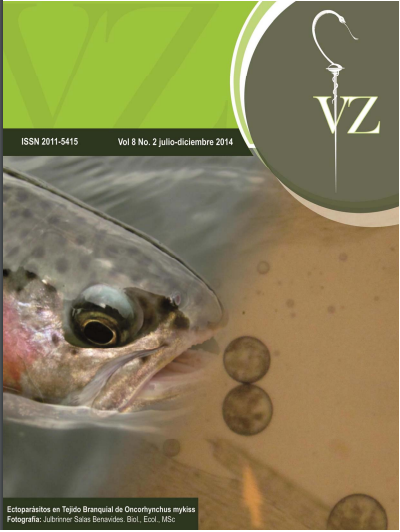Authors
Abstract
ABSTRACT: The study was performed during 12 months in floating cages at the ‘Intiyaco’ fish station, which belongs to Universidad de Nariño, located in the Guamez lake, in the Department of Nariño (Colombia). A total of 194 specimens of rainbow trout (Oncorhynchusmykiss) with a weight range from 8.74 to 168.85 grams,
and total length from 100.12 mm to 220.66 mm were analyzed. The study aimed to identify the main parasitic entities that affect the O.myk iss species and to evaluate the prevalence rate, the effect of the association between parasitical pathologies and their impact in the different stages of cultivation and production. Data were subjected to Multivariate Analysis, Chi square test and logistic regression analysis using the SPSS 20 - Statistical Package (2013). Results demonstrate that parasitic patologies are mainly found in the gill chamber, with significant prevalence (P<0.05) of the following species: Gyrodactylus (34.76%);Dactylogyrussp (27.59%); Trichodinasp(21.67%); and Ichthyophthiriussp (15.98%). The research demonstrated that 35% larvae and 23% juvenile rainbow trout showed exoparasitosis infestations. The differential analysis of the number of parasites, average value of total length and weight of O. mykiss fish per cultured stage in floating cages determined higher prevalence of unicellular parasites during the larval stage of rainbow trout, affecting the weight and length of diseased fish (9.28 g and 10.98 mm) compared to healthy animals (12.75 g and 180.37 mm). Also the number of animals getting sick during the larviculture phase was higher than 65.5% in relation to species infested during the growing phase.
Keywords
References
Benz, G. & Bullard, S. Metazoan parasites andassociates of Chondrichthyans with emphasis on taxa harmful to captive host. In:The elasmobranch husbrandry Manual:Captive care of sharks, Rays and their Relatives. Ohio, USA.: Ohio Biological Survey. 2004. p. 325‐416.
Boyd, C. Water Quality in Ponds for Aquaculture. Alabama Agricultural. Alabama,USA.: Auburn University. 2000.
Chisholm, L. & I., W. Invasion of the shovelnose ray (Rhinobatos typus) by Neoheterocotyle rhinobatidis and Merizocotyle icopae (Monogenea: Monocotylidae).
Parasitology. Volume 127, Issue 06, pp 561‐570. 2003. Copyright © 2003 Cambridge University Press.
Holmes, J. Helminth communities in marine fishes In: Parasites communities: patterns and processes. London: Chapman and Hall, 1990.
Keiser, J.; Utzinger, J. Emerging foodborne trematodiasis. Emerging Infectious Diseases, v. 11, n. 10, p. 1507‐1514, 2005.
Kennedy, C. & Williams, H. Helminth parasite community diversity in a marine fish Raja comuniatís. Journal of Fish Biology. Volume 34, Issue 6, pages 971–972, June 1989.
Kennedy, C. & Bush, C. Patterns in helminth communities: why are birds and fish different?. Parasitology,Volume 93,Issue 01,pp 205‐215. 1986.Copyright © Cambridge University Press 1986.
Kennedy, C. & Hartvigsen, A. Richness and diversity of intestinal metazoan communities in brown trout Salmo trutta compared to those of eels Anguilla anguilla in their European heartlands. Parasitology, Volume 121, Issue 01, pp 55‐64. 2000. Cambridge University Press. July 2000.
Kennedy, CK.; Bakke, TA. Diversity patterns in helminth communities in common gulls. Parasitology, Volume 98, Issue 03, June 1989, pp 439‐445Copyright © Cambridge University Press 1989.
López, J. & Rubio, E. Vulnerabilidad de las especies ícticas nativas con relación a especies ícticas introducidas de la cuenca alta del río Cauca. Zootecnia, v. 4, n. 7, p. 9‐ 20, 2001.
Lopez, J. & Rubio, E. Estudio de parámetros sanguíneos como indicadores de salud de los peces de la cuenca alta del rió cauca en el departamento del valle del cauca. Memorias, IV Seminario internacional de acuicultura, I Congreso nacional de investigaciones acuícolas, IV Muestra comercial de acuicultura. Bogotá, Colombia. 2003. URL:http://www.iiap.org.pe/publicaciones/CDs/MEMORIAS. _VALIDAS/contenidos.pdf.
López‐Macías, J. Nutrición y Alimentación Piscícola. Colombia: Editorial Universidad de Nariño, 2014.
Luque, JL.; Poulin, R. Metazoan parasite species richness in Neotropical fishes: hotspots and the geography of biodiversity. Parasitology, Volume 134, Issue 06, pp 865‐878. Copyright © Cambridge University Press. 2007.
Putman, R. Community ecology. London: Chapman & Hall, 1994.
Rohde, K. Ecology of Marine Parasites. Wallingtonford, RU.: CABI, 1993.
Rohde, K.; Hayward, C.; Heap, M. Aspects of the ecology of metazoan ectoparasites of marine fishes. International Journal for Parasitology, 1995 Aug; 25 (8): 945‐70.
Roldán, G. & Ramírez, J. Fundamentos de Limnología Neotropical. Medellín, Colombia: Universidad de Antioquia, 2008.
Salas‐Benavides, J. Evaluación de la ginogénesis de Oncorhynchus mykiss utilizando choque térmico de 27ºC a dferentes periodos de exposicion en el Centro Ambiental Guairapungo (Nariño). Veterinaria y Zootecnia, v. 6, n. 2, 2012.
Salgado‐Maldonado, G.; Rubio‐Godoy, M. Helmintos parásitos de peces de agua dulce introducidos. En: Mendoza, R. y Koleff, P. (coords.). Especies acuáticas invasoras en México. México: Comisión Nacional para el Conocimiento y Uso de la Biodiversidad, 2014.
Torres, P.; Jercic, M.I.; Weitz, J.C.; Dobrew, E.K.; Mercado, R.A. Human pseudoterranovosis, an emerging infection in Chile. The Journal of Parasitology, v. 93, n. 2, p. 440‐443, 2007.
Vásquez, ZG. Guía de Laboratorio para Análisis de Calidad de Aguas. Popayán, Colombia: Universidad del Cauca, 2005.
Vidal‐Martínez V. Spatial and temporal repeatability in parasite community structure of tropical fish hosts. Centre of Research and Advanced Studies of the National Polytechnical Institute. Mérida, Yucatán, México. 2003. Parasitology, Volume 127, Issue 04, 387‐398. 2003. Copyright © 2003 Cambridge University Press.
Vidal‐Martínez, V.; Aguirre‐Macedo, M.; Scholz, T.; González‐Solís, D.; Mendoza‐ Franco, E. Atlas de los helmintos parásitos de cíclidos de México. México: Instituto Politécnico Nacional, 2002.
Violante‐González, J.; Aguirre‐Macedo, M. Saccocoelioides lamothei n. sp. from Dormitator latifrons (Pisces: Eleotridae) from coastal lagoons of Guerrero. Revista Mexicana de Biodiversidad, v. 79, 2008.
Violante‐González, J.; Aguirre‐Macedo, M.; Mendoza‐Franco, E. A checklist of metazoan parasites of fish from Tres Palos lagoon, Guerrero. Mexico: parasitology Research, 2007.
Weins, J. Phylogenetic Analysis of Morphological Data. En Smithsonian Series Comparative Evolucionary Biology. Washington, D.C.: Erwin D.H y V.A. funk Smithsonian institution press, 2000. p. 220.
Vuong, P.N.; Richard, F.; Snounou, G.; Coquelin, F.; Rénia, L.; Gonnet, F.; Chabaud, A.G.; Landau, I. Development of irreversible lesions in the brain, heart and kidney following acute and chronic murine malaria infection. Parasitology, v. 119, n. 6, p. 543‐553, 1999.

 PDF (Español)
PDF (Español)
 FLIP
FLIP










